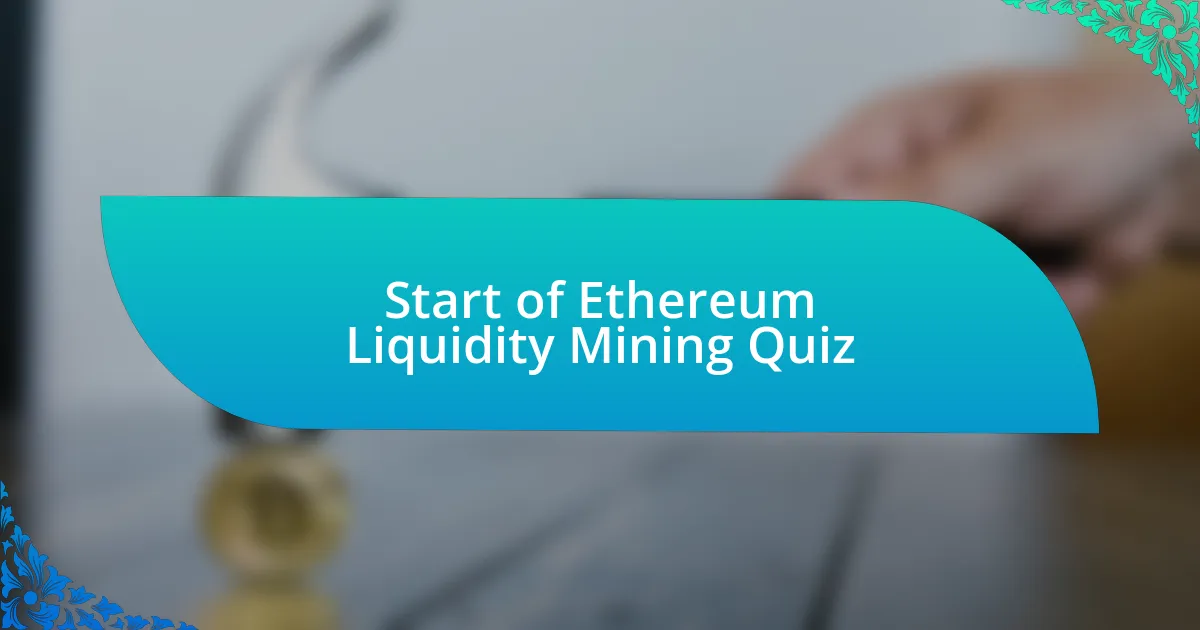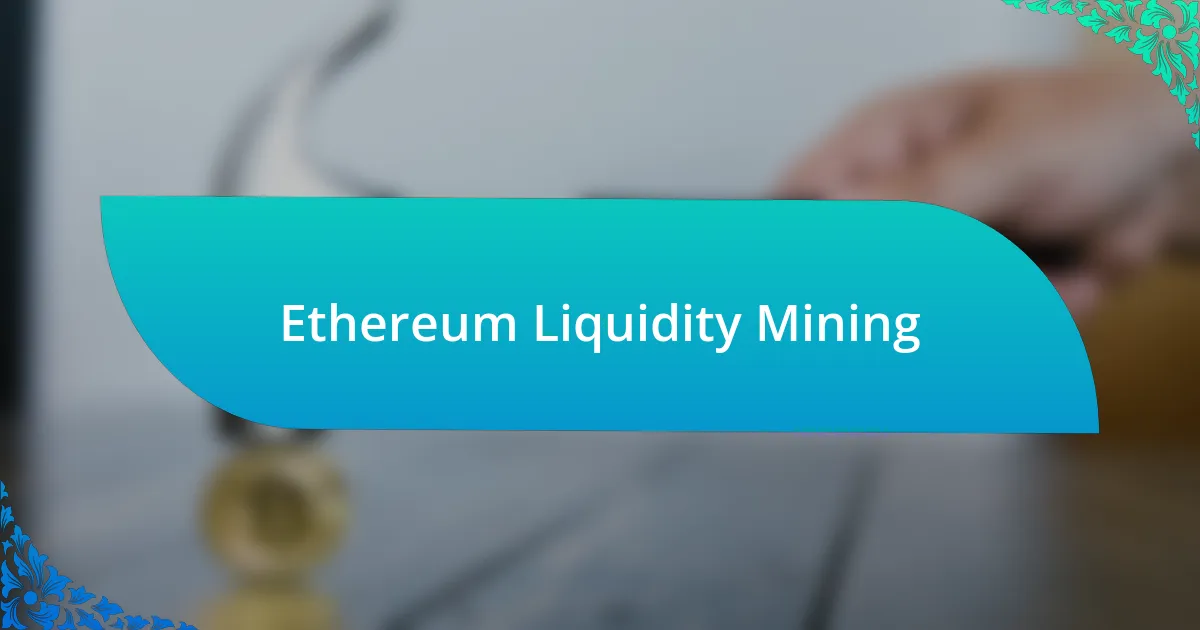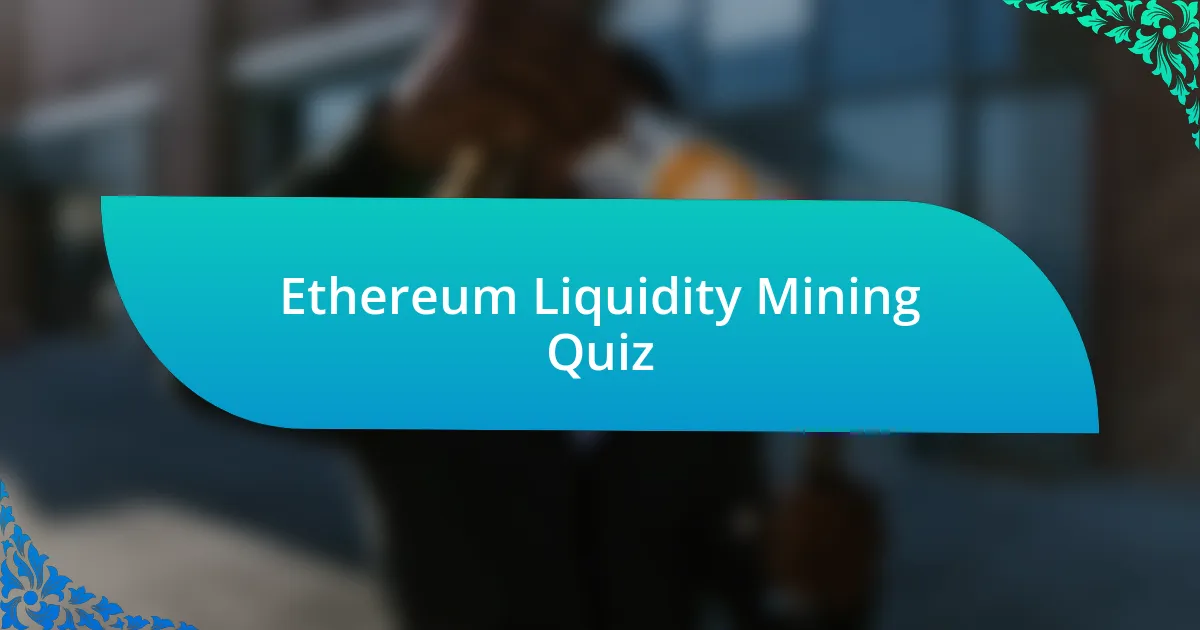
Start of Ethereum Liquidity Mining Quiz
1. What is liquidity mining?
- Liquidity mining is a method for trading stocks on centralized exchanges.
- Liquidity mining is a process where participants contribute crypto assets to liquidity pools in return for fees and tokens.
- Liquidity mining is a strategy for acquiring real estate investments systematically.
- Liquidity mining is a way to earn interest on traditional bank savings accounts.
2. What are liquidity pools?
- Liquidity pools are physical banks that store cash for investors.
- Liquidity pools are virtual vaults containing deposited digital assets from liquidity miners.
- Liquidity pools are warehouses for holding tangible goods before selling.
- Liquidity pools are online forums where traders meet to exchange strategies.
3. How do decentralized exchanges (DEXs) use liquidity pools?
- DEXs use liquidity pools to create centralized trading environments.
- DEXs use liquidity pools to facilitate P2P swaps without centralized authorities.
- DEXs use liquidity pools to directly manage cryptocurrency wallets.
- DEXs use liquidity pools to store user private information securely.
4. What is an automated market maker (AMM)?
- An AMM is an algorithmic framework used by DEXs to confirm P2P swaps.
- An AMM is a physical marketplace where buyers and sellers meet to trade.
- An AMM is a type of traditional bank that offers loans to traders.
- An AMM is a manual process for managing trades on centralized exchanges.
5. What happens to transaction fees in liquidity pools?
- Transaction fees are kept by the decentralized exchange as profit.
- Transaction fees are evenly dispersed between all liquidity providers when the deal is completed.
- Transaction fees are automatically sent to a charitable organization.
- Transaction fees are burned to reduce the total supply of tokens.
6. How are liquidity providers compensated?
- Liquidity providers receive a flat fee regardless of their contribution.
- Liquidity providers are compensated based on the quantity of liquidity they provide to the liquidity pool.
- Liquidity providers earn rewards based on their trading performance.
- Liquidity providers are compensated via fixed monthly salaries from exchanges.
7. What are liquidity provider tokens (LP tokens)?
- LP tokens are rewards distributed for holding cryptocurrencies in wallets.
- LP tokens are credits that users receive for trading on centralized exchanges.
- LP tokens are digital currencies used for purchasing assets on exchanges.
- LP tokens are special tokens received by liquidity providers in return for their contribution to liquidity pools.
8. What is impermanent loss in liquidity mining?
- Impermanent loss happens when liquidity providers withdraw their tokens too early.
- Impermanent loss refers to the fees charged for using a liquidity pool service.
- Impermanent loss is when tokens become locked in a liquidity pool indefinitely.
- Impermanent loss occurs when the value of the original tokens contributed to a pool fluctuates in price.
9. How do DEXs operate?
- DEXs operate through physical exchanges where users meet and trade tokens directly.
- DEXs operate using smart contract-based pools that represent specific trading pairs or collections of tokens.
- DEXs operate without the use of any digital assets or cryptocurrencies.
- DEXs operate by relying on central authorities to manage transactions and trades.
10. What is the role of smart contracts in liquidity pools?
- Smart contracts limit the contribution of liquidity providers to specific tokens only.
- Smart contracts ensure that there`s no risk of centralized counterparty interference in liquidity pools.
- Smart contracts create manual operations for trading in liquidity pools.
- Smart contracts allocate trading fees solely to the platform developers.
11. What is the primary benefit of liquidity mining?
- Earning passive income through trading fees and protocol tokens.
- Receiving fixed interest payments regardless of market conditions.
- Reducing the risk of market volatility completely.
- Gaining instant access to all crypto on the platform.
12. How do liquidity miners benefit from their contributions?
- Liquidity miners earn rewards solely from token appreciation in the pool.
- Liquidity miners benefit by earning a share of the pool’s trading fees and protocol tokens as incentives.
- Liquidity miners benefit by selling their deposited tokens at high market prices.
- Liquidity miners receive fixed amounts of tokens regardless of their contributions.
13. What is the difference between liquidity mining and yield farming/staking?
- Liquidity mining and staking are identical processes without any differences.
- Liquidity mining only involves traditional financial markets, while yield farming is exclusive to cryptocurrencies.
- Liquidity mining is about depositing fiat currencies, whereas yield farming deals exclusively with digital assets.
- Liquidity mining is a subset of yield farming, while staking involves locking crypto for blockchain validation.
14. What happens when traders swap crypto pairs in a liquidity pool?
- Traders don`t incur any fees when swapping crypto pairs; all transactions are free on the platform.
- Traders receive tokens when swapping crypto pairs, which are distributed randomly among pools.
- Traders are charged a flat fee regardless of the amount swapped, which is held by the DEX.
- Traders pay fees when swapping crypto pairs, which flow to participating liquidity providers proportional to their contribution.
15. How do liquidity providers earn rewards?
- Liquidity providers earn rewards as traders buy and sell from the liquidity pools.
- Liquidity providers earn rewards by holding onto their assets without usage.
- Liquidity providers earn rewards by participating in centralized exchanges only.
- Liquidity providers earn rewards through fixed interest on their deposits.
16. What is the role of DEXs in liquidity mining?
- DEXs provide the platform for liquidity mining by deploying AMMs and facilitating token swaps.
- DEXs act as custodians of crypto assets and control all user funds.
- DEXs only focus on centralized trading strategies for liquidity mining.
- DEXs require liquidity providers to stake their tokens for extended periods.
17. What are the risks associated with liquidity mining?
- The risks include guaranteed profits and fixed interest rates.
- The risks include impermanent loss, smart contract vulnerabilities, and potential scams.
- The risks include excessive regulation and mandatory fees on transactions.
- The risks include limited asset availability and high withdrawal times.
18. How do liquidity providers deposit tokens into liquidity pools?
- Liquidity providers purchase shares in a stock market to gain access to liquidity pools.
- Liquidity providers mine tokens through solving cryptographic puzzles.
- Liquidity providers stake their tokens in a centralized bank account for interest.
- Liquidity providers deposit equal proportions of tokens into liquidity pools to ensure ample liquidity.
19. What is the purpose of liquidity pools in decentralized exchanges?
- The purpose is to create a system that requires fewer participants to trade effectively.
- The purpose is to provide liquidity for traders to buy and sell tokens directly from and to the smart contract.
- The purpose is to increase the value of tokens by reducing supply in the market.
- The purpose is to centralize trading and control market prices for efficiency.
20. How do DEXs support liquidity mining?
- DEXs support liquidity mining by using AMMs and smart contracts to manage liquidity pools.
- DEXs support liquidity mining by offering loans on margin trading.
- DEXs support liquidity mining by collecting user deposits in centralized wallets.
- DEXs support liquidity mining by implementing high fees for transactions.
21. What is the definition of liquidity mining in traditional finance?
- Liquidity mining is a method of borrowing funds from the bank to invest in stocks.
- Liquidity mining refers to the process of selling bonds to raise immediate cash for corporations.
- In traditional finance, liquidity mining involves saving accounts that yield interest over time.
- In traditional finance, liquidity mining is similar to market makers providing liquidity to the market and earning from the bid-ask spread.
22. What happens to the assets of liquidity providers when they contribute to a pool?
- The assets are burned and cannot be recovered.
- The assets are automatically converted to stablecoins.
- The assets are temporarily locked up in the liquidity pool.
- The assets are sent to a centralized exchange for trading.
23. How do liquidity providers qualify for DEX events?
- Liquidity providers can qualify for DEX events by holding LP tokens.
- Liquidity providers must stake a minimum amount of ETH.
- Liquidity providers qualify by meeting high trading volume requirements.
- Liquidity providers are selected randomly by the DEX.
24. What are the benefits of liquidity mining?
- The benefits include minimum fees, centralized control, complex regulations, and limited access.
- The benefits include manual trading, frequent withdrawals, solitary investments, and fixed returns.
- The benefits include passive income, high yield potential, DEX support, and community development.
- The benefits include high risk, instant profits, exclusive access, and reduced competition.
25. What is the relationship between liquidity mining and DEXs?
- Liquidity mining means providing liquidity to traditional financial institutions only.
- Liquidity mining involves borrowing assets from DEXs for investment purposes.
- Liquidity mining is a type of trading strategy exclusive to centralized exchanges.
- Liquidity mining is facilitated by DEXs using AMMs and smart contracts.
26. How do DEXs ensure fairness in liquidity pools?
- DEXs use a centralized system to allocate rewards among liquidity providers.
- DEXs rely on community votes to decide how fees are distributed.
- DEXs monitor all trades manually to determine fairness in liquidity pools.
- DEXs ensure fairness through smart contracts that manage the distribution of transaction fees.
27. What is the difference between traditional finance and DeFi liquidity mining?
- Traditional finance relies on centralized banks, while DeFi works with stock exchanges and brokers.
- Traditional finance does not allow for trading, while DeFi enables speculation with no restrictions.
- Traditional finance involves market makers, while DeFi uses decentralized exchanges and automated market makers.
- Traditional finance is limited to fiat currencies, while DeFi includes only cryptocurrencies without regulations.
28. How do liquidity providers manage their LP tokens?
- Liquidity providers can manage their LP tokens by converting them into any cryptocurrency instantly.
- Liquidity providers can manage their LP tokens by redeeming, staking, trading, or qualifying for DEX events.
- Liquidity providers can manage their LP tokens by burning them for rewards.
- Liquidity providers can manage their LP tokens by holding them in a wallet without further action.
29. What is the impact of price fluctuations on liquidity mining?
- Price fluctuations lead to guaranteed profits for liquidity miners.
- Price fluctuations can result in impermanent loss for liquidity providers.
- Price fluctuations have no effect on liquidity mining at all.
- Price fluctuations cause liquidity pools to become irrelevant over time.
30. How do DEXs handle token swaps?
- DEXs handle token swaps by providing a centralized exchange platform for users.
- DEXs handle token swaps via a peer-to-peer network that requires user verification.
- DEXs handle token swaps using AMMs and smart contracts to ensure efficient and decentralized trading.
- DEXs handle token swaps through manual order books managed by traders.

Quiz Successfully Completed!
Congratulations on finishing the quiz on Ethereum Liquidity Mining! This topic is vital for understanding how decentralized finance (DeFi) operates. You have explored key concepts, from liquidity pools to rewards, that play a significant role in the Ethereum ecosystem. Each question has helped reinforce your knowledge and perhaps even sparked new interests in the mechanics of liquidity provisioning.
Through this quiz, you likely learned about the risks and benefits associated with liquidity mining. It’s essential to grasp how participating can yield rewards, but it also involves being aware of potential impermanent loss. This balance is crucial in navigating the DeFi landscape effectively. Your newfound insights will empower you to make informed decisions in your cryptocurrency ventures.
If you’re eager to delve deeper, we invite you to check out the next section on this page. You will find a wealth of information about Ethereum Liquidity Mining. This resource will expand your understanding and keep you updated on the latest trends and strategies. Broadening your knowledge will surely enhance your experience in the vibrant world of DeFi!

Ethereum Liquidity Mining
Understanding Ethereum Liquidity Mining
Ethereum liquidity mining involves providing liquidity to decentralized finance (DeFi) platforms in exchange for rewards. Users deposit their assets into liquidity pools, which facilitate trading on decentralized exchanges. By doing so, liquidity providers earn transaction fees and often receive token incentives. This mechanism enhances market liquidity, enabling smoother trades without large price impacts.
The Mechanism of Liquidity Pools in Ethereum
Liquidity pools are smart contracts that hold funds for trading purposes in decentralized exchanges. Users contribute assets to these pools, which allows other users to swap tokens seamlessly. The pool’s balance of different tokens enables automated pricing through mechanisms like the constant product formula. This self-sustaining model attracts users by offering liquidity providers a share of the fees generated from transactions within the pool.
Benefits of Participating in Ethereum Liquidity Mining
Participating in Ethereum liquidity mining offers multiple benefits. Liquidity providers earn passive income through transaction fees. Additionally, users often receive governance tokens for the protocols they support, giving them voting rights on protocol decisions. Furthermore, liquidity mining can yield high returns, especially during periods of increased trading volume. Risks include impermanent loss and smart contract vulnerabilities.
Popular Platforms for Ethereum Liquidity Mining
Several platforms facilitate Ethereum liquidity mining. Uniswap and SushiSwap are two leading decentralized exchanges that enable users to provide liquidity and earn rewards. Other notable platforms include Balancer and Curve Finance, which offer unique liquidity solutions tailored for specific token pairs. Each platform has its own incentives and mechanisms, allowing users to choose based on their specific strategies.
Risks Associated with Ethereum Liquidity Mining
Despite its benefits, Ethereum liquidity mining carries inherent risks. Impermanent loss occurs when the value of deposited tokens fluctuates, potentially resulting in lower returns than holding the assets outright. Moreover, the risk of smart contract exploits exists, as vulnerabilities can lead to total loss of funds. Users should conduct thorough research and understand the protocols they engage with to mitigate these risks.
What is Ethereum Liquidity Mining?
Ethereum Liquidity Mining is a process in which users provide liquidity to decentralized finance (DeFi) platforms in exchange for rewards, typically in the form of tokens. This process helps facilitate trading and ensures sufficient liquidity for various pairs on decentralized exchanges (DEXs) built on the Ethereum blockchain. According to DeFiPulse, as of October 2023, over $10 billion is locked in liquidity mining protocols on Ethereum, illustrating its significance in the DeFi ecosystem.
How does Liquidity Mining work in Ethereum?
Liquidity mining on Ethereum works by allowing users to deposit their cryptocurrency assets in liquidity pools. In return, they receive liquidity provider (LP) tokens that represent their share of the pool. These LP tokens can earn the user rewards, typically through a protocol’s native tokens. For instance, when users participate in liquidity mining for a DEX like Uniswap, they obtain rewards proportional to their contribution, incentivizing users to maintain liquidity.
Where can one participate in Ethereum Liquidity Mining?
Users can participate in Ethereum liquidity mining on various decentralized finance platforms, such as Uniswap, SushiSwap, and Balancer. Each of these platforms has specific pools and associated rewards for providing liquidity. As of October 2023, Uniswap remains one of the largest platforms, with more than $4 billion in locked liquidity, making it a central hub for liquidity mining activities.
When did Liquidity Mining become popular on Ethereum?
Liquidity mining gained significant popularity on Ethereum in mid-2020, notably during the “DeFi Summer.” This period saw a surge in decentralized finance projects that offered high yields for liquidity providers. The launch of protocols like Compound and Yearn.finance contributed to this trend, with Compound’s governance token distribution model sparking widespread interest in liquidity mining practices.
Who benefits from Ethereum Liquidity Mining?
Liquidity mining benefits various participants in the DeFi ecosystem. Liquidity providers gain rewards in the form of tokens, increasing their potential returns. Automated market makers (AMMs) benefit from improved liquidity, enabling smoother trades. Additionally, traders benefit from lower slippage and better execution prices. According to Dune Analytics, liquidity providers on Uniswap have earned cumulative rewards worth over $1 billion since its inception, highlighting the financial incentives involved.

